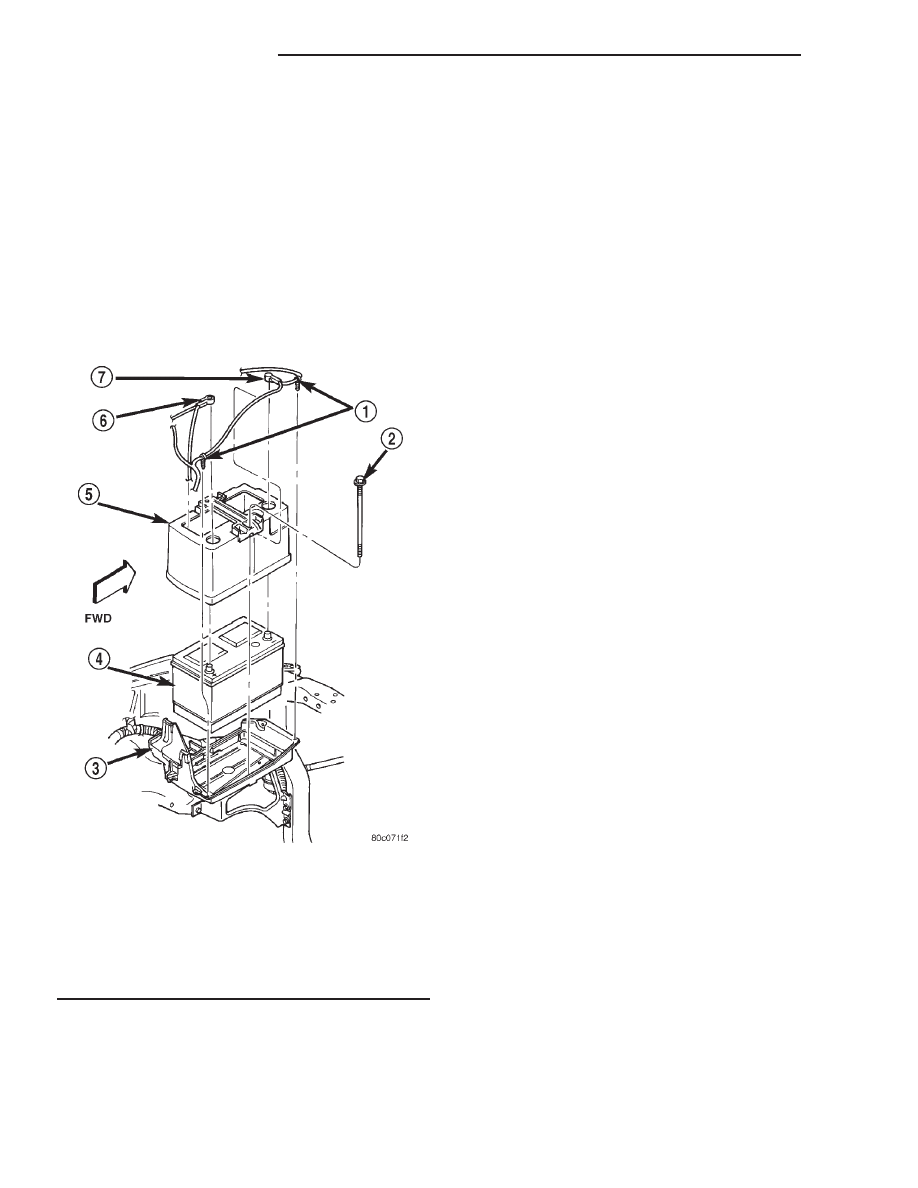Dodge Dakota (R1). Manual - part 299

the terminal clamp pinch-bolt hex nut to 7.9 N·m (70
in. lbs.).
(6) Reconnect the battery negative cable terminal
clamp to the battery negative terminal post. Tighten
the terminal clamp pinch-bolt hex nut to 7.9 N·m (70
in. lbs.).
(7) Apply a thin coating of petroleum jelly or chas-
sis grease to the exposed surfaces of the battery cable
terminal clamps and the battery terminal posts.
BATTERY HOLDDOWN
DESCRIPTION
The battery hold down hardware (Fig. 18) includes
two bolts, two U-nuts and a hold down strap/battery
thermoguard unit. The molded plastic battery hold
down strap is integral to the battery thermoguard
unit, which encloses the sides of the battery case.
When installing a battery into the battery tray, be
certain that the hold down hardware is properly
installed and that the fasteners are tightened to the
proper specifications. Improper hold down fastener
tightness, whether too loose or too tight, can result in
damage to the battery, the vehicle or both. Refer to
Battery Hold Downs in this section for the location
of the proper battery hold down installation proce-
dures, including the proper hold down fastener tight-
ness specifications.
OPERATION
The battery holddown secures the battery in the
battery tray. This holddown is designed to prevent
battery movement during the most extreme vehicle
operation conditions. Periodic removel and lubrica-
tion of the battery holddown hardware is recomended
to prevent hardware seizure at a later date.
NOTE: Never operate a vehicle without a battery
holddown device properly installed. Damage to the
vehicle, components and battery could result.
REMOVAL
(1) Turn the ignition switch to the Off position. Be
certain that all electrical accessories are turned off.
(2) Loosen the battery negative cable terminal
clamp pinch-bolt hex nut.
(3) Disconnect the battery negative cable terminal
clamp from the battery negative terminal post. If
necessary, use a battery terminal puller to remove
the terminal clamp from the battery post.
(4) Disconnect the battery positive cable terminal
clamp from the battery positive terminal post. If nec-
essary, use a battery terminal puller to remove the
terminal clamp from the battery post.
(5) Remove the two hold down bolts that secure
the hold down strap/battery thermal guard unit to
the U-nuts in the battery tray (Fig. 19).
(6) Remove the hold down strap/battery thermal
guard unit from the top of the battery case.
INSTALLATION
(1) Clean and inspect the battery hold down hard-
ware. Refer to Battery in the index of this service
manual for the location of the proper battery hold
down hardware cleaning and inspection procedures.
(2) Install the hold down strap/battery thermo-
guard unit over the top of the battery case.
(3) Install and tighten the two hold down bolts
that secure the hold down strap/battery thermoguard
unit to the U-nuts in the battery tray. Tighten the
bolts to 2.1 N·m (19 in. lbs.).
(4) Reconnect the battery positive cable terminal
clamp to the battery positive terminal post. Tighten
Fig. 18 Battery Hold Downs
1 - CLIPS
2 - BOLT
3 - TRAY
4 - BATTERY
5 - HOLD DOWN STRAP AND THERMAL GUARD
6 - POSITIVE CABLE
7 - NEGATIVE CABLE
8F - 18
BATTERY SYSTEM
AN
BATTERY (Continued)